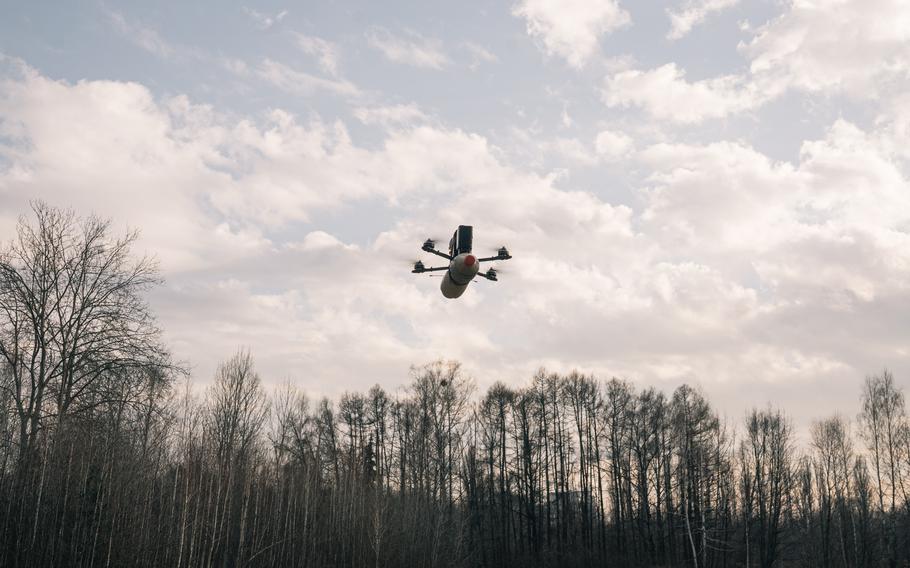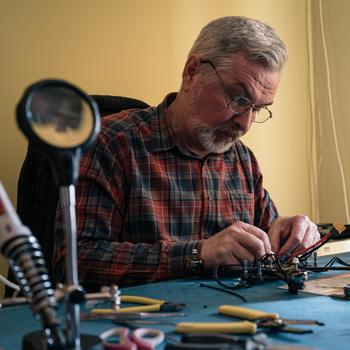Europe
As Ukraine runs low on ammo, civilians build troops DIY drones at home
The Washington Post April 28, 2024

A homemade FPV drone hovers during testing. (Alice Martins/for The Washington Post)
KYIV REGION, Ukraine — Before Russia invaded, Magdalyna, a florist, used a simple desk in her suburban home to assemble bouquets. Now it’s where she builds drones.
Bouquets are heavier but otherwise the two products are not so different, she said. Both “make other people happier.”
Magdalyna, 27, is among a growing number of Ukrainians who are building equipment for the military at home because they fear Russia is going to advance on the front lines and further destroy their country. Like several others in this article, The Washington Post is identifying Magdalyna only by first name due to security concerns.
Since last year, she has built 150 first-person view drones (commonly known as FPVs) and repaired hundreds of others, including Russian drones that Ukrainian troops collect after they crash on the front lines.
She has raised more than $200,000 to buy drone parts from China, largely raised through online donations, although she and her husband, an IT professional, have also spent some of their own money.
FPVs, civilian drones redesigned by Ukrainian soldiers to carry explosives, have transformed Ukraine’s battlefield and are widely deployed by each side. The drones, which are small enough to maneuver into trenches and take enemy troops by surprise, became more crucial in recent months as Ukraine ran out of artillery shells and other ammunition while waiting for Western support, including from the United States.
Operators launch the handheld devices from positions behind the contact line, then — using goggles and a remote controller — fly into enemy territory and guide them into Russian targets, killing or wounding infantry and destroying equipment. Russia noticed the efficacy of FPVs and now mass produces them for its own troops.
Ukraine also has started making FPVs and other drones in factories — with a pledge to make 1 million this year — but many drones sent to Ukrainian troops are being made by regular people at home. The civilians do not handle any explosives, which are only attached after the drones are delivered to the front. One advantage to the crowdsourcing is that it is decentralized, with private homes less vulnerable to Russian missile attacks than a large-scale military factory.
Instead of complex assembly lines, volunteers are transforming their own spaces into makeshift drone workshops. Magdalyna calls her home office her “drone room.” A stack of FPVs sit next to other supplies she uses to build the drones, including a soldering iron, copper wire, pliers, a screwdriver, acid and zip ties soldiers use to attach their bombs.
A grass-roots group called SocialDrone is one of the local initiatives that has taught hundreds of volunteers how to make drones — sharing lists of components to be purchased online and written instructions of how to put them together. The group also published a detailed bird’s eye view YouTube video demonstrating the process, which has been viewed more than 400,000 times since November.
Once volunteers finish building their FPVs, they send them to the group, which vigorously tests the homemade drones before shipping them to the front. Drone-builders can request a device be sent to a specific soldier or unit, including their own friends or family, or they can let SocialDrone choose a brigade in need.
“A DIY FPV drone for ~250 euros can do the job of a 1 shot Javelin for 70,000 euros,” the group’s website states.
Oleksii Asanov, an IT worker who co-founded SocialDrone, never intended to get involved in drone making.
A volunteer since the first days of Russia’s 2022 invasion, Asanov also founded other projects to support soldiers at the front. One sends them drone launching systems and another trains soldiers as drone pilots in a 10-day intensive course.
After the first troops graduated from his school, they complained that they returned to the front with new skills but no drones. Given the intensity of fighting, troops often deploy on a mission with five or more FPVs, then use them as self-destructing weapons that fly into a target. This sort of one-time use means new drones are in constant demand.
Asanov said that for Ukraine to stand a chance in the war, it must keep up with this demand. “It seems for me that this war will be ended with FPV drones,” he said.
He recruited several friends and last year launched a Telegram channel introducing the project. He shared a shopping list of items to buy — and most people purchase the parts from AliExpress, the Chinese online shopping platform. “There are a lot of people who want to help,” he recalled thinking. “Why can’t we just make clear instructions and give [them] to people?”
After the how-to guide was published, requests for where to send the finished drones started pouring in. First, they received five drones. The next week, seven. Then 13. By February, they got 400 in a single week. They have now received about 5,000 drones and have tested and sent 4,500 to the front. Donations keep coming in — including one recently from a stranger who overheard Asanov speaking about his project to Post reporters in a cafe in Kyiv.

Ivan Bilodid, 65, builds an FPV drone in his home in Moschun, Ukraine. Russian troops lived in his home during their occupation. Now he makes drones to send to the Ukrainian military. (Alice Martins/for The Washington Post)
The group’s YouTube video is how Ivan Bilodid, 65, first learned of the project. A thermal energy engineer with a specialty in nuclear power installations, he studied physics in Moscow in the 1970s and, while watching the video, thought building an FPV looked like something he could figure out.
For Bilodid, it was also personal.
He lives in Moschun, a suburb of Kyiv that turned into the front line when Russian troops advanced on Kyiv in February 2022. For days, Bilodid sheltered in a neighbor’s basement with 27 people. Eventually, he fled — not knowing if he would ever return home.
After Russian troops retreated, he learned they had entered his house. Looters went through his belongings, stealing his laptop and his wife’s jewelry. His home was also badly damaged from shelling, costing him tens of thousands of dollars out of his own pocket so far on repairs.
That experience “certainly pushed me to help somehow,” he said.
Bilodid advertised his plans on social media, shared requests for help fundraising with friends and by March had sent 12 drones to the front line.
Yan, 13, also came across the YouTube video. He grew up playing with Legos and other construction toys and thought building an FPV would not be so hard.
His parents helped him buy the parts, but prefer he does not work on building drones on school nights. So, on Saturdays and Sundays, he spends about five hours a day assembling them. He has worked on four drones so far and his school has promised to help him make more if he keeps it up.
“I’m angry with the enemy but I’m also happy,” he said. “I’m interested in what I’m doing, it’s a new hobby.”
Each weekend, dozens of volunteers test drones in parks and fields around Kyiv.
On a recent Saturday, Kyrylo, 32, and Denys, 23, sorted through stacks of donated drones and tried flying them one at a time.
The two men are former soldiers who were wounded. Now they do quality control testing for SocialDrone, running the drones through complicated maneuvers to be sure the device won’t fall apart. They also attach water bottles filled with sand to simulate the weight of explosives, making sure each FPV sent to the front can be fitted with a weapon.
Between tests, they helped another volunteer, Anna, 33, practice flying. A product marketer working on a mobile app, Anna overheard one of SocialDrone’s co-founders talking about the project in a shared workspace in January and joined as a volunteer right away. Now, she spends so much time on drones that “it’s like another full-time job,” she said.
After testing, the group places each drone in one of three piles: excellent, decent and nonfunctional. Most arrive in good condition, they said, but the DIY process also means there are errors. Once the drones are cleared, they are shipped to the front line. Soldiers often send back photos thanking volunteers for the drones — and occasionally footage showing how they used them to eliminate Russian troops.
“I never thought there would be a moment when someone would die and I feel good about it,” Magdalyna said. But the war has changed her.
“I’m happy they die with my help,” she said of enemy Russian soldiers, “only because they will not kill us tomorrow.”